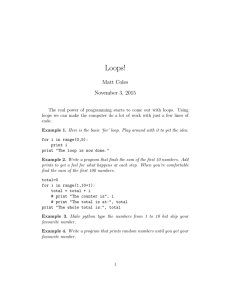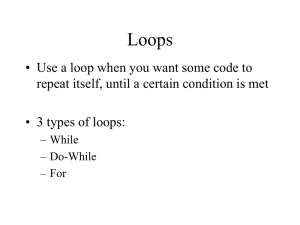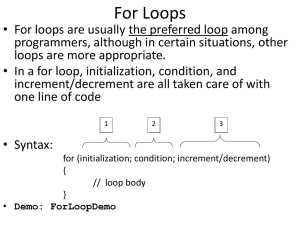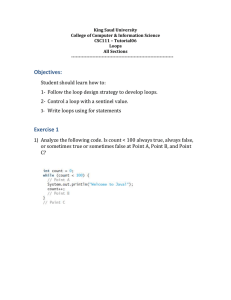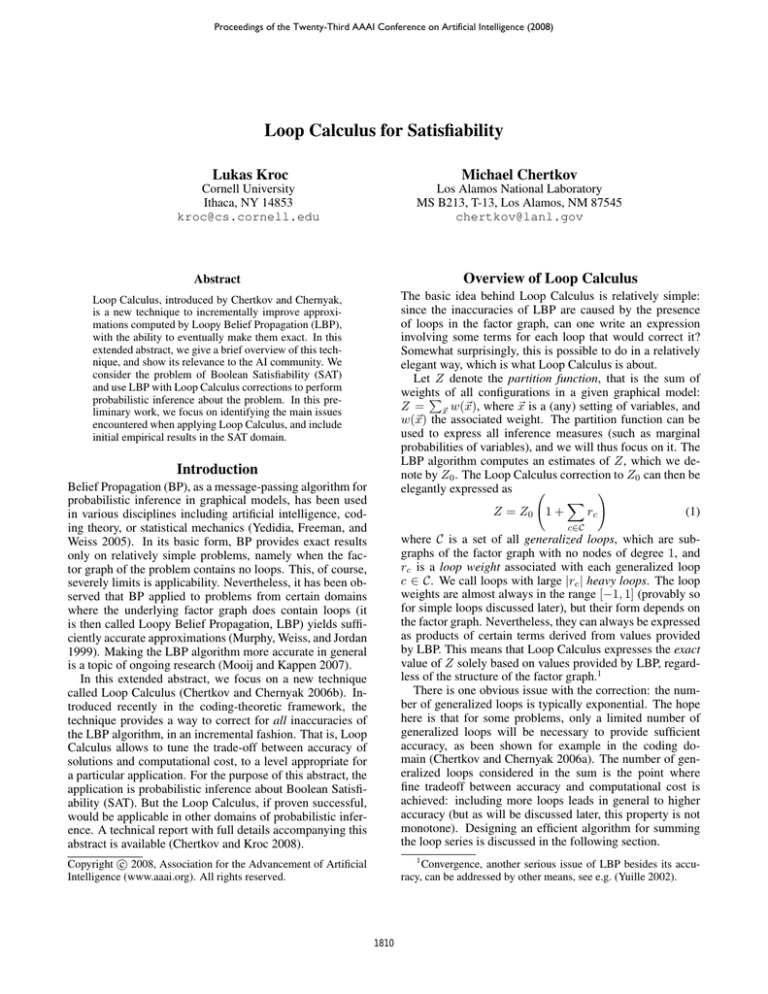
Proceedings of the Twenty-Third AAAI Conference on Artificial Intelligence (2008)
Loop Calculus for Satisfiability
Lukas Kroc
Michael Chertkov
Cornell University
Ithaca, NY 14853
kroc@cs.cornell.edu
Los Alamos National Laboratory
MS B213, T-13, Los Alamos, NM 87545
chertkov@lanl.gov
Abstract
Overview of Loop Calculus
Loop Calculus, introduced by Chertkov and Chernyak,
is a new technique to incrementally improve approximations computed by Loopy Belief Propagation (LBP),
with the ability to eventually make them exact. In this
extended abstract, we give a brief overview of this technique, and show its relevance to the AI community. We
consider the problem of Boolean Satisfiability (SAT)
and use LBP with Loop Calculus corrections to perform
probabilistic inference about the problem. In this preliminary work, we focus on identifying the main issues
encountered when applying Loop Calculus, and include
initial empirical results in the SAT domain.
The basic idea behind Loop Calculus is relatively simple:
since the inaccuracies of LBP are caused by the presence
of loops in the factor graph, can one write an expression
involving some terms for each loop that would correct it?
Somewhat surprisingly, this is possible to do in a relatively
elegant way, which is what Loop Calculus is about.
Let Z denote the partition function, that is the sum of
weights
P of all configurations in a given graphical model:
Z = ~x w(~x), where ~x is a (any) setting of variables, and
w(~x) the associated weight. The partition function can be
used to express all inference measures (such as marginal
probabilities of variables), and we will thus focus on it. The
LBP algorithm computes an estimates of Z, which we denote by Z0 . The Loop Calculus correction to Z0 can then be
elegantly expressed as
Ã
!
X
Z = Z0 1 +
rc
(1)
Introduction
Belief Propagation (BP), as a message-passing algorithm for
probabilistic inference in graphical models, has been used
in various disciplines including artificial intelligence, coding theory, or statistical mechanics (Yedidia, Freeman, and
Weiss 2005). In its basic form, BP provides exact results
only on relatively simple problems, namely when the factor graph of the problem contains no loops. This, of course,
severely limits is applicability. Nevertheless, it has been observed that BP applied to problems from certain domains
where the underlying factor graph does contain loops (it
is then called Loopy Belief Propagation, LBP) yields sufficiently accurate approximations (Murphy, Weiss, and Jordan
1999). Making the LBP algorithm more accurate in general
is a topic of ongoing research (Mooij and Kappen 2007).
In this extended abstract, we focus on a new technique
called Loop Calculus (Chertkov and Chernyak 2006b). Introduced recently in the coding-theoretic framework, the
technique provides a way to correct for all inaccuracies of
the LBP algorithm, in an incremental fashion. That is, Loop
Calculus allows to tune the trade-off between accuracy of
solutions and computational cost, to a level appropriate for
a particular application. For the purpose of this abstract, the
application is probabilistic inference about Boolean Satisfiability (SAT). But the Loop Calculus, if proven successful,
would be applicable in other domains of probabilistic inference. A technical report with full details accompanying this
abstract is available (Chertkov and Kroc 2008).
c∈C
where C is a set of all generalized loops, which are subgraphs of the factor graph with no nodes of degree 1, and
rc is a loop weight associated with each generalized loop
c ∈ C. We call loops with large |rc | heavy loops. The loop
weights are almost always in the range [−1, 1] (provably so
for simple loops discussed later), but their form depends on
the factor graph. Nevertheless, they can always be expressed
as products of certain terms derived from values provided
by LBP. This means that Loop Calculus expresses the exact
value of Z solely based on values provided by LBP, regardless of the structure of the factor graph.1
There is one obvious issue with the correction: the number of generalized loops is typically exponential. The hope
here is that for some problems, only a limited number of
generalized loops will be necessary to provide sufficient
accuracy, as been shown for example in the coding domain (Chertkov and Chernyak 2006a). The number of generalized loops considered in the sum is the point where
fine tradeoff between accuracy and computational cost is
achieved: including more loops leads in general to higher
accuracy (but as will be discussed later, this property is not
monotone). Designing an efficient algorithm for summing
the loop series is discussed in the following section.
1
Convergence, another serious issue of LBP besides its accuracy, can be addressed by other means, see e.g. (Yuille 2002).
c 2008, Association for the Advancement of Artificial
Copyright °
Intelligence (www.aaai.org). All rights reserved.
1810
Summing the Loop Series
even though there is only a small fraction of them overall.
Omitting them results in a large error (the N curve), despite
the effort spent on summing 99.8% of all generalized loops.
Increasing the size of the problems, we look at random
3-SAT instances with 100 variables. The table below shows
results for two instances with different clause-to-variable
ratio α. The loop correction series is summed across all
(multi-)simple loops with |rc | ≥ 0.001.
¡
P ¢
The simplest way to make the exponentially long sum in (1)
feasible for evaluation is to truncate it at a certain point. If
enough heavy loops have been summed till then, the resulting correction might already be sufficiently accurate. This
turns out to be the case in coding, where considering just
one (heaviest) loop is already an improvement in the decoding algorithm (Chertkov and Chernyak 2006a). An important question in a particular problem is thus whether there
are “reasonably few” generalized loops that allow for “sufficient accuracy”, and if so, whether one can find them efficiently (Gómez, Mooij, and Kappen 2007).
Finding heaviest loops is a difficult problem in general,
but a slight restriction yields a practical approach for finding
at least very heavy loops. The restriction is that we will
only consider simple loops, consisting of only one cycle.
The expression for the weights of generalized loops in case
of binary variables (being a product of terms mostly from
[−1, 1]) suggests that the more nodes and edges in a loop,
the lower its weight |rc |. This justifies our focus on simple loops. The problem of finding the heaviest simple loop
can be viewed as searching for the minimal-weight cycle in
a certain graph with labeled and weighted edges, such that
each edge label appears at most once. We have developed
an A∗ -style search algorithm which, while not polynomial
in the worst case, is very efficient even on instances with
thousands of variables. Moreover, besides finding the heaviest simple loop, it can also output all simple loops ordered
by decreasing |rc |, which is what we ultimately need to approximate the loop series. One way to perform the series
truncation is to sum up only simple loops above a certain
weight threshold. We include preliminary results for such
approach in the Empirical Validation section below.
α
3.0
3.5
exact count Z
1.97 × 1010
6.66 × 108
LBP’s Z0
4.34 × 1010
2.60 × 108
Z0 1 +
rc
2.09 × 1010
2.46 × 108
Some observations can be readily made: Loop Calculus can
provide a significant improvement in the accuracy (the first
instance), although as the LBP’s estimate Z0 gets more inaccurate, Loop Calculus requires more fine terms in the series,
and can sometimes worsen the estimate (second instance).
This points out the non-monotonic behavior also observable in the figure above. Additional empirical results can
be found in the technical report (Chertkov and Kroc 2008).
Summary and Future Work
Loop Calculus, while not yet a fully developed technique,
might provide a very useful tool for improving accuracy of
standard LBP in various domains, including many in AI.
This work discusses application of Loop Calculus to the
problem of reasoning about SAT. While the preliminary results show that in general, there are many issues making the
application to SAT difficult, it also shows that improvement
is possible, given a suitable problem domain. The most important future work will look into alternative ways of summing the loop series, as well as identifying more domains
where Loop Calculus is efficient, and significantly increases
the accuracy of LBP.
References
We first apply Loop Calculus to a toy SAT instance with 4
solutions, which allows to consider all generalized loops and
thus fully observe the behavior of the method.
Chertkov, M., and Chernyak, V. Y. 2006a. Loop calculus helps to
improve belief propagation and linear programming decodings of
low-density-parity-check codes. In Proc. 44th Allerton Conf.
Chertkov, M., and Chernyak, V. Y. 2006b. Loop series for discrete
statistical models on graphs. Journal of Statistical Mechanics:
Theory and Experiment 2006(06):P06009.
Chertkov, M., and Kroc, L. 2008. Loop calculus for satisfiability, LAUR 08-0321, http://www.cs.cornell.edu/
w8/˜kroc/misc/pub/loop sat.pdf.
Gómez, V.; Mooij, J. M.; and Kappen, H. J. 2007. Truncating
the loop series expansion for belief propagation. J. Mach. Learn.
Res. 8:1987–2016.
Mooij, J. M., and Kappen, H. J. 2007. Loop corrections for
approximate inference on factor graphs. J. Mach. Learn. Res.
8:1113–1143.
Murphy, K.; Weiss, Y.; and Jordan, M. I. 1999. Loopy beliefpropagation for approximate inference: An empirical study. In
Proc. of UAI’99, 467–475.
Yedidia, J. S.; Freeman, W. T.; and Weiss, Y. 2005. Constructing free-energy approximations and generalized belief propagation algorithms. Inf. Theory, IEEE Trans. on 51(7):2282–2312.
Yuille, A. L. 2002. CCCP algorithms to minimize the bethe and
kikuchi free energies: convergent alternatives to belief propagation. Neural Comput. 14(7):1691–1722.
Empirical Validation
P
The above figure shows estimated Z = Z0 (1+ c∈Loops rc )
on the y-axis, where Z0 = 4.55 and Loops is a set of,
respectively, all loops, only simple loops and non overlapping simple loops (multi-simple loops) and only non-simple
loops (all the others). X-axis is the fraction of the respective
loops used in the sum, ordered by decreasing |rc |. There are
682 (multi-)simple loops, and 329, 664 non-simple loops.
The figure confirms that simple loops are very important,
1811

